
Concept explainers
Name each

(a)
Interpretation: The nomenclature of given alkane is to be stated and each carbon as
Concept introduction: The aliphatic hydrocarbons that have only
Answer to Problem 34P
The IUPAC name of given alkane is
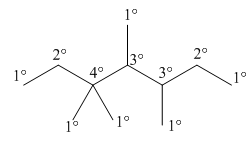
Figure 6
Explanation of Solution
The given ball and stick model of alkane is,

Figure 1
In ball-and-stick model, each colored ball represents a specific atom and each stick represents a bond. In this model, each black ball represents
Thus, the skeletal structure of given alkane is,
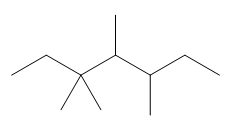
Figure 2
One should follow the given four steps to give the IUPAC name of a compound. The first step is naming of longest parent chain.
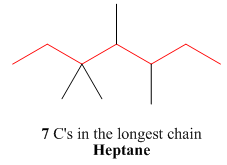
Figure 3
The second step is numbering of chain.
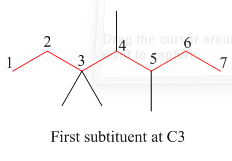
Figure 4
The third step is naming and numbering of substituents.
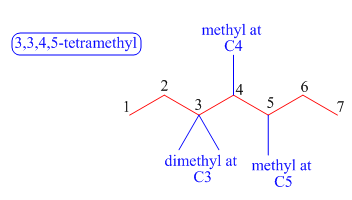
Figure 5
The fourth step is combining of all parts.
Thus, the IUPAC name of given alkane is
The aliphatic hydrocarbons that have only
Thus, each carbon as

Figure 6
The IUPAC name of given alkane is
(b)
Interpretation: The nomenclature of given alkane is to be stated and each carbon as
Concept introduction: The aliphatic hydrocarbons that have only
Answer to Problem 34P
The IUPAC name of given alkane is
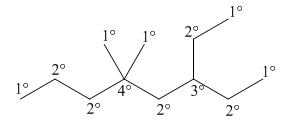
Figure 12
Explanation of Solution
The given ball and stick model of alkane is,

Figure 7
In ball-and-stick model, each colored ball represents a specific atom and each stick represents a bond. In this model, each black ball represents
Thus, the skeletal structure of given alkane is,
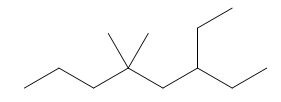
Figure 8
One should follow the given four steps to give the IUPAC name of a compound. The first step is naming of longest parent chain.
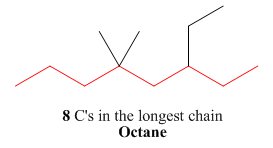
Figure 9
The second step is numbering of chain.
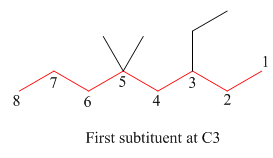
Figure 10
The third step is naming and numbering of substituents.
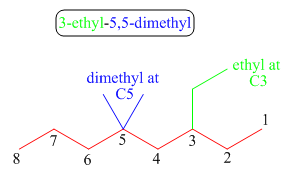
Figure 11
The fourth step is combining of all parts.
Thus, the IUPAC name of given alkane is
The aliphatic hydrocarbons that have only
Thus, each carbon as

Figure 12
The IUPAC name of given alkane is
Want to see more full solutions like this?
Chapter 4 Solutions
EBK ORGANIC CHEMISTRY
Additional Science Textbook Solutions
Organic Chemistry (8th Edition)
Campbell Essential Biology with Physiology (5th Edition)
General, Organic, and Biological Chemistry - 4th edition
Biology: Concepts and Investigations
- Please correct answer and don't used hand raitingarrow_forwardQ1: Curved Arrows, Bronsted Acids & Bases, Lewis Acids & Bases Considering the following reactions: a) Predict the products to complete the reactions. b) Use curved electron-pushing arrows to show the mechanism for the reaction in the forward direction. Redraw some of the compounds to explicitly illustrate all bonds that are broken and all bonds that are formed. c) Label Bronsted acids and bases in the left side of the reactions. Label conjugate acids and bases in the right side of the reactions. d) Label Lewis acids and bases, nucleophiles and electrophiles in the left side of the reactions. A. + OH CH30: OH B. + HBr C. H₂SO4 D. CF 3. CH 3 + HCI N H fluoxetine antidepressant 1↓ JDownloadarrow_forwardDon't used Ai solutionarrow_forward
- Part 3: AHm,system Mass of 1.00 M HCI Vol. of 1.00 M HCI Mass of NaOH(s) Total Mass in Calorimeter Mole product if HCI limiting reactant Trial 1 62.4009 1.511g Mole product if NaOH limiting reactant Limiting reactant Initial Temperature Final Temperature 23.8°C 37.6°C Change in Temperature AHm,system (calculated) Average AHm,system (calculated) (calculated) (calculated) Trial 2 64.006g 1.9599 (calculated) (calculated) (calculated) (calculated) (calculated) (calculated) 24.7°C 41.9°C (calculated) (calculated) (2 pts. each)arrow_forwardDon't used Ai solutionarrow_forwardWhat is the numerical value of the slope using the equation y=-1.823x -0.0162 please show calculationsarrow_forward
- Don't used hand raitingarrow_forward1.) Using the graph below (including the line equation of y = -1.823x - 0.0162) What is the numerical value for the slope shown? 2.) What are the Unit(s) associated with the slope of the line shown? for we all remember that numerical data always has units. 3.) What would be a good title for this graph and explain your choice. 0.00 0.0 02 0.4 10.6 08 10 12 -0.20 -0.40 -0.60 -0.80 Temp, freezing, in degrees Celcius 5-1.00 -1.20 -1.40 -1:60 y=-1.823x-0.0162 -180 -2.00 Concentration of Sucrose (m)arrow_forwardDon't used Ai solutionarrow_forward
- Identify the Functional Groups (FG) in the following molecules. Classify C atoms as tertiary, 30, or quaternary 40. Identify secondary 20 and tertiary, 30 hydrogen atoms. Please provide steps to undertand each labeling. Please label in the image, so it fits explanation. I am still very unsure I undertand this.arrow_forwardDon't used Ai solutionarrow_forwardDon't used Ai solutionarrow_forward
 Chemistry & Chemical ReactivityChemistryISBN:9781337399074Author:John C. Kotz, Paul M. Treichel, John Townsend, David TreichelPublisher:Cengage Learning
Chemistry & Chemical ReactivityChemistryISBN:9781337399074Author:John C. Kotz, Paul M. Treichel, John Townsend, David TreichelPublisher:Cengage Learning Chemistry & Chemical ReactivityChemistryISBN:9781133949640Author:John C. Kotz, Paul M. Treichel, John Townsend, David TreichelPublisher:Cengage Learning
Chemistry & Chemical ReactivityChemistryISBN:9781133949640Author:John C. Kotz, Paul M. Treichel, John Townsend, David TreichelPublisher:Cengage Learning Organic And Biological ChemistryChemistryISBN:9781305081079Author:STOKER, H. Stephen (howard Stephen)Publisher:Cengage Learning,
Organic And Biological ChemistryChemistryISBN:9781305081079Author:STOKER, H. Stephen (howard Stephen)Publisher:Cengage Learning, General, Organic, and Biological ChemistryChemistryISBN:9781285853918Author:H. Stephen StokerPublisher:Cengage Learning
General, Organic, and Biological ChemistryChemistryISBN:9781285853918Author:H. Stephen StokerPublisher:Cengage Learning Introduction to General, Organic and BiochemistryChemistryISBN:9781285869759Author:Frederick A. Bettelheim, William H. Brown, Mary K. Campbell, Shawn O. Farrell, Omar TorresPublisher:Cengage Learning
Introduction to General, Organic and BiochemistryChemistryISBN:9781285869759Author:Frederick A. Bettelheim, William H. Brown, Mary K. Campbell, Shawn O. Farrell, Omar TorresPublisher:Cengage Learning Chemistry: The Molecular ScienceChemistryISBN:9781285199047Author:John W. Moore, Conrad L. StanitskiPublisher:Cengage Learning
Chemistry: The Molecular ScienceChemistryISBN:9781285199047Author:John W. Moore, Conrad L. StanitskiPublisher:Cengage Learning





